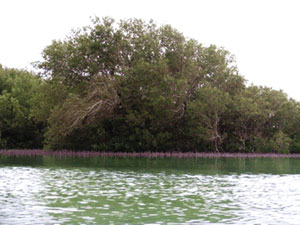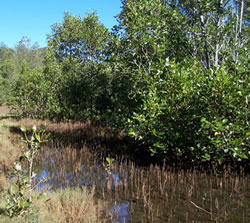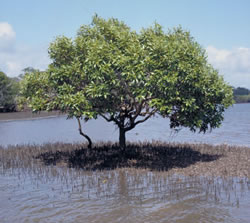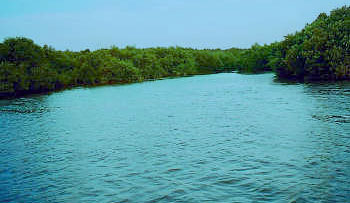PREVENTION FROM SUNAMI PERIOD...................................................................................................................................................................................................................................................................................
Avicennia Marina (Alaiyathi Tree) The Avicennia marina (locally called alaiyathi), the trees are tall and the respiratory roots form a kind of neat fence above the ground. The Chief's Corner, a 11 sq. km. lagoon, with a thatched hut and a boardwalk through the mangroves is an interesting spot. With the Forest Department's permission, tourists are allowed to picnic here. 30% of Rhizophora was affected in low saline microhabitat and most of Avicennia marinathem died due to continuous submergence (subduction affect) and tsunami. Avicennia marina are not affected. 30% of Rhizophora was affected and most of them died due to Avicennia marina continuous submergence (subduction affect) and tsunami. Avicennia marina and Sonneratia alba are not affected. 40% of Rhizophora was affected and most of them died due to Rhizophora apiculatacontinuous inundation (subduction of land) and tsunami. Avicennia marina are thriving. 80% of Rhizophora was affected in low saline microhabitat and died Rhizophora apiculatadue to continuous submergence (subduction of land) and tsunami. Avicennia marina are thriving.
Avicennia marina can be very massive with a tree diameter of more than a meter and a height of about 30 m, whereas the landward specimens are stunted shrubs of less than 2 m height. Like other species within the same genus, Avicennia marina is a pioneering mangrove and is frequently found on sandy beaches or dead seagrass heaps as a sapling. Avicennia marina sensu lato has the broadest latitudinal and longitudinal distribution of all mangrove species and can be found from the East coast of Africa (from the Red Sea to South-Africa) to the West-Pacific (from Japan to New Zealand). Where trunks are massive, they often contain crevices that are a home to different crab species. Also root and leaf morphology varies between the two zones, and preliminary research even revealed slight genetic differences. On aerial photographs Avicennia marina is also easily recognised because of its tonality which is the lightest of all mangrove species in East-AfricAvicennia The above ground root system of Avicennia marina is characterized by upright pencillike pneumatophores which originate from an underground cable root. The length of these pneumatophores seem to be dependend on inundation time. More uncommon on Avicennia marina are short aerial roots originating directly on the stem, usually very close to the ground, but often just hanging from the stem without anchoring in the ground. In Kenya, Avicennia marina typically displays a double zonation pattern, occuring on the coastal edge of the mangroves as tall trees (up to about 15 m), as well as on the terrestrial edge, often exhibiting various degrees of dwarf-growth depending on the salinity and on the drainage of the site.
Flowers Very small, typically 0.5 cm, orange in color, Fruit Avicennia marina has developped a certain degree of viviparity, refered to as criptoviviparity (the embryo grows out of the seed coat, but does not emerge from the fruit). The seeds of Avicennia marina have a velvet capsule. In areas with low salinities, leaves are lanceolate, with a pointed apex and are on average 15 cm long. In an extremely saline environment, leaves are more elliptical with a rounded apex they are more leathery and are very small (2cm length in extreme conditions). The underside of the leaves have a typical greyish-whitish color, due to the presence of small hairs. On the upperside of the leaves, salt cristals, excreted by the leaves can be observed.
Leaves measure up to 8cm long and 5cm wide, are oval, pointed and arranged opposite one another on the stems. Grey mangroves can also withstand short periods of inundation by freshwater or hypersaline water (salinity exceeding that of seawater). Grey mangrove grows to 25 metres high, however trees of 10 to 15 metres are common in Queensland under favourable conditions. The grey mangrove stabilises river banks and channels, providing areas for spat settlement in oyster culture, is a source of pollen for bee keepers, and provides suitable habitats for waterbirds and juveniles of important recreational and commercial fish species. |
|
||||||
|
|
|||||||







